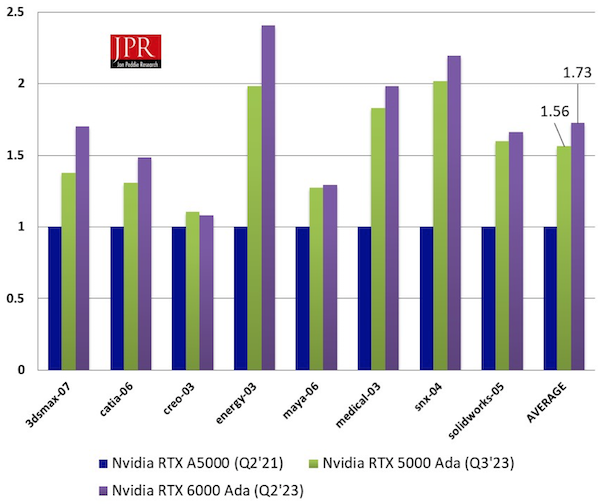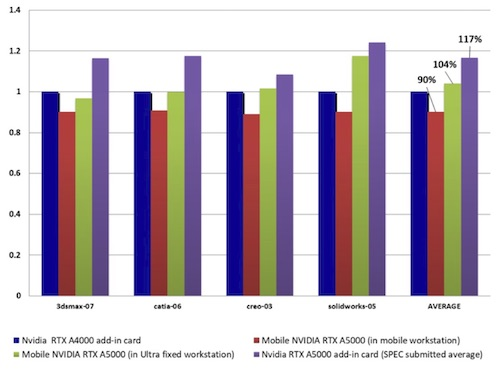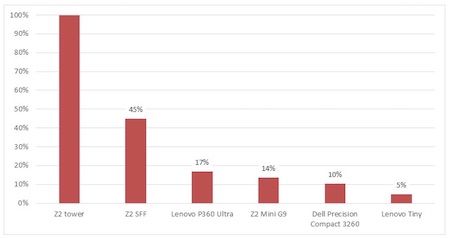An oft-quoted cliché from decades ago spouted advice to computing IT shoppers: “Nobody ever got fired for buying IBM.” Though arguably misguided, the point was that IBM — the widely acknowledged leader in sales, breadth, and quality of computing technology at the time — was the safe choice. You couldn’t go wrong buying from IBM.
In today’s market for professional-caliber GPUs, NVIDIA is yesterday’s IBM. Though it commands minority share, AMD gives NVIDIA a serious run for its money in the market for gaming GPUs. Not so though in the market for GPUs geared specifically for professional applications like CAD, where NVIDIA’s Quadro brand holds an overwhelming edge over AMD’s Radeon Pro. Based on my tracking for Jon Peddie Research, NVIDIA now commands over 95% of the market for discrete GPUs shipping in workstations.
Buyers tend to default to NVIDIA (transitioning from the Quadro brand to simply RTX), and without strong end-user pull for Radeon Pro, OEMs like Dell, HP and Lenovo, are more than content to simply ship the default brand. In fact, vendors like Lenovo have often offered nothing but NVIDIA options in its ThinkStation deskside workstations, and when considering only mobile workstation shipments, NVIDIA virtually owns the segment.
Why? It’s been more a case of NVIDIA winning the market than AMD losing it. AMD’s products have proven consistently capable, but it takes more than just proficient products to capture share, when the market leader’s wares are considered the default, like IBM’s of yore. NVIDIA would need to stumble, or AMD would have to deliver a knockout punch with a new generation of products to significantly change the status quo. And, that just hasn’t happened, or at least not to the extent to clear the necessary market hurdles.
The Latest Generations in GPU Tech for CAD: NVIDIA’s Ampere and AMD’s RDNA2
Of course, market fortunes can change, and if there’s any company that should have faith in that possibility, it’s AMD. On the CPU side of the business, it’s hard to imagine a vendor outperforming expectations more dramatically than AMD has done over the past several years. As covered several times in this column (most recently December 2020's column and January 2021's column in the context of the highly-competitive Zen 3 powered Ryzen 5000 product line), the combination of AMD’s development of the Zen microarchitecture along with its choice to tie its fortunes to the manufacturing capabilities of TSMC (Taiwan Semiconductor Manufacturing Corporation), has pushed its CPUs to match or exceed those of the market leader Intel.
Can the same resurgence happen in the market for professional GPUs? It always can, but it will take some work. The latest battlelines have formed, with NVIDIA’s new Ampere generation RTX brand products squaring off against the recently launched RDNA2-powered Radeon Pro GPUs from AMD. I dug into Ampere technology here, followed up with subsequent CAD-relevant products here, and more recently covered RDNA2 here. Still early in their respective product lifecycles at the time, I did not have the appropriate hardware to perform meaningful comparisons of any two RDNA2 and Ampere products, at least not in a context tailored to CAD computing. Fortunately, I was ultimately able to circle back and do just that, benchmarking CAD-relevant workloads on a suitable sample set of recent workstation-caliber Ampere and RDNA2 GPUs.
On the Ampere side are the new ultra-high end RTX A5000 and high end RTX A4000, along with the popular Quadro RTX 4000 from the company’s previous generation Turing class. And, representing RDNA2 are the ultra-high end AMD Radeon Pro W6800 and mid-range W6600. While the respective products don’t match up exactly with respect to current ASPs, there are obvious comparisons to make at several common market price tiers.

Specifications for recent NVIDIA Ampere and AMD RDNA2 generation professional GPUs. (Image source: AMD and NVIDIA)
3D Graphics Benchmarking Results Cast Some Light on the Relative Merits
Still, the essential measure of a GPU for CAD is how well it performs processing 3D graphics for visuals common to AEC, manufacturing, and design workloads. Though prospective buyers may look to the GPU to take on additional processing roles — from engineering simulation to rendering (explored ahead) — 3D graphics performance remains the crucial purchase criterion for the vast majority. Toward that end, I employ the best — albeit not perfect — standard benchmark focused on 3D graphics for professional applications: SPEC’s SPECviewperf, most recently updated to SPECviewperf 2020.
Let’s start with the upper end of the market, one I split into ultra-high–end (>$1,500 ASP) and high-end (between $1500 and $950). While prices naturally keep volume low, you may be surprised to learn that the combination of the two segments contribute more than half of all professional GPU add-in card revenue (that is, not including mobile-oriented GPUs for mobile applications). There is a lot of money being spent at the upper end, albeit not typically from buyers representing mainstream CAD applications. Regardless, comparing the $2,200 AMD Radeon Pro W6800 with the $2,900 NVIDIA RTX A5000 makes for a reasonable comparison of the relative merits of Ampere and RDNA2.
Processing SPECviewperf 2020’s 3D viewsets — pulled from popular CAD packages like Solidworks CATIA and PTC Creo, among a range of professional applications — the RTX A5000 outperformed the Radeon Pro W6800 by 21%, on average. Tempering that performance edge though is the RTX A5000’s 30%+ higher price.

SPECViewperf 2020 raw scores for ultra-high–end NVIDIA RTX A5000 (Ampere) normalized to the AMD Radeon Pro W6800 (RDNA2) GPUs.
Stepping down the price bands, we find some SKUs a bit more accessible to CAD budgets, ranging from NVIDIA’s Ampere-generation still-not-quite-mainstream $1,150 RTX A4000, the preceding Quadro RTX 4000 (released almost three years ago), and AMD’s just released and legitimately mainstream $700 Radeon Pro W6600. Again, we don’t have a fair fight based on price, and the higher priced RTX A4000 outperforms its predecessor by about 35% on average, while the Radeon Pro W6600 comes up about 20% short.

SPECViewperf 2020 raw scores for high-end NVIDIA RTX A4000 (Ampere) and mid-range AMD Radeon Pro W6600 (RDNA2) GPUs, normalized to the previous-gen NVIDIA Quadro RTX 4000.
Based on traditional 3D graphics for CAD usage, both generations deliver solid performance. The NVIDIA Ampere SKUs benchmarked here hold an edge over AMD Radeon Pro SKUs, and for the minority of buyers for which price is a minor criterion, the RTX A series is likely to draw more buyers, particularly when NVIDIA already represents the default brand.
For Most, Price-Performance the More Relevant Criterion
Performance measurements in the absence of price may be the key criterion for some, but for the vast majority price does matter. In that context, the raw composite scores above aren’t the fairest comparison. While I was able to benchmark appropriate SKUs with ASPs in the same neighborhood, the NVIDIA Ampere cards are consistently more expensive than their closest AMD RDNA2 rival. In this case then, a more equitable comparison would be to weigh price-performance, and when looking at SPECviewperf scores per dollar, the Ampere and RDNA2 offerings are on remarkably equal footing. On average across viewsets, the Radeon Pro W6800 edges out the NVIDIA RTX A5000 by a few percent while the RTX A4000 nudges out the Radeon Pro W6600 by a similarly small margin. (Bear in mind that any changes in ASP would translate to commensurate adjustments in price-performance, possibly flipping these slight advantages.)

SPECViewperf 2020 raw scores-per-dollar for ultra-high–end NVIDIA RTX A5000 (Ampere) normalized to the AMD Radeon Pro W6800 (RDNA2) GPUs.

SPECViewperf 2020 scores-per-dollar for high-end NVIDIA RTX A4000 (Ampere) and mid-range AMD Radeon Pro W6600 (RDNA2) GPUs, normalized to the previous-gen NVIDIA Quadro RTX 4000.
Ultimately then, for those most focused on getting the best bang-for-the-buck for 3D graphics, the two generations appear comparable. That conclusion is a logical one, as AMD GPU products in particularly have historically been pushed to price points specifically to be competitive with NVIDIA’s similarly positioned GPUs.
Evaluations Based on 3D Graphics Does Not Show Complete Picture
3D graphics processing, executed by a dedicated GPU, has long represented the foundation of interactive 3D content creation, be it performed for CAD, media, and entertainment, or many smaller fields of application. The word “interactive” is the critical one in the previous statement, as the priority of 3D graphics from its inception has always been speed. Yes, of course, achieving the most realistic imagery was important as well, but not if it meant losing interactivity.
When it came to that other goal, producing the most photorealistic imagery possible, users have long turned to rendering. A process that is far more time-consuming — hence why it historically has not been an interactive tool — rendering typically employs the tracing of light rays through a 3D scene. As the ray bounces around within the scene, the computer accumulates the interaction of that light on surfaces and materials using precise, physically based calculations to determine how to shade viewport pixels. Rendering has traditionally been performed not on the GPU but the CPU — or in the case of Hollywood-caliber CGI created with tools like the ubiquitous Pixar Renderman, it’s processed by a sea of CPUs scattered across dedicated server render farms.
That was the status quo for decades: use 3D graphics accelerated on GPUs for interactive performance and good 3D imagery or use rendering processed on CPUs for best possible visuals delivered with a substantial wait time. The former was the better tool for the type of iterative development common in CAD (and other 3D applications), while the latter was better in late or final stages of development where the form was pretty well congealed and users were instead looking to get the most subtle visual details for aesthetic or marketing purposes.
But in recent years, the two tools have been on a bit of a collision course. 3D graphics has constantly improved its visual fidelity with more and more complex algorithms, while rendering speed has gotten closer and closer to interactive rates. It was only a matter of time before GPUs took the leap to add functionality to close that gap. NVIDIA did just that in 2017, introducing ray tracing hardware acceleration in its flagship Volta GPU, and improving that support in subsequent Turing and now Ampere generations. And, AMD has responded by launching its new RDNA2 generation with ray-tracing acceleration, now accessible in popular applications like Solidworks and Autodesk Inventor (with more plug-ins to come).
With the two visualization methods now stepping on each other’s toes, evaluating GPUs based solely on 3D graphics performance — as I’ve done above — is no longer a complete exercise. Yes, for the vast majority, 3D graphics performance remains the top-priority criterion, as it’s what today drives productivity for CAD’s common and time-consuming, iterative design, and refinement workflow. But with real-time performance — or at least closer to real-time performance, depending on scene, lighting, and material complexity — rendering’s role has grown. With Turing and Ampere GPUs from NVIDIA, and now RDNA2 GPUs from AMD, CAD users have performance rendering at their disposal. This evolution will change the balance of 3D graphics and rendering that users will employ moving forward.
So, how do Ampere and RDNA2 compare when it comes to rendering? Unfortunately, that’s a more difficult question to answer, at least precisely and quantitatively. The problem is the instrumentation to create an apples-to-apples scenario to test — same content, same software, same visual characteristics — is not readily available (or at least not accessible to me with this exercise). For the minority who prioritize rendering over 3D graphics today, the analysis above is incomplete. But, for the majority who will continue to lean most heavily on 3D graphics — while turning to rendering more often — it’s probably reasonable to state that both Ampere and RDNA2 deliver enough capabilities for your workflow and any differences won’t weigh in your purchase criteria (at least not yet, but expect that situation to change significantly in coming years).
For more on the evolving role of rendering in development, NVIDIA’s move to pursue real-time rendering with dedicated ray tracing hardware in GPUs, and AMD’s response to its rival’s strategy, check out these previous columns on rendering support in Ampere (here and here) and RDNA2 (here and here).
With Comparable Price/Performance, Will RDNA2 and Ampere Shake Up the Status Quo in the Market for CAD-focused GPUs?
With the default duopoly of AMD and NVIDIA launching new generations of GPU that serve CAD applications, the obvious question is whether Ampere and RDNA2 will impact the two vendors’ disparate position in the marketplace. The short answer looks to be no. It’s not that RDNA2 doesn’t represent a capable 3D graphics platform — now with rendering acceleration to boot — and it delivers a solid bump in performance (and performance/watt) over AMD’s previous generation Radeon Pro wares. The problem for AMD is NVIDIA is doing anything but stumble.
At the upper end of the market, NVIDIA’s position appears secure. The issue with the W6800 is not that it doesn’t offer solid price-performance — it does, at least from the perspective of 3D graphics (and I’ll give it the benefit of the doubt on rendering). It’s that at the upper end, price is a less critical criterion, so the RTX A5000’s overall higher performance may trump the W6800’s very competitive price-performance. It's a different story with the W6600, however, as it sits in a far more price-sensitive segment. And, for those who don’t naturally default to NVIDIA, it represents appealing bang-for-the-buck. But it doesn’t hold any significant advantage either, and given it’s NVIDIA’s business to lose, it’s hard to see these respective generations significantly changing positions in the market. (It’s worth noting that this exercise, I was not able to get my hands on the RTX A4000’s lower-priced sibling, the very new RTX A2000. Assuming a price point at or beneath the Radeon Pro W6600, the RTX A2000 may shift the competitive balance yet again).
Ultimately, from a market perspective, I wouldn’t expect to see any major changes in the vendors’ relative market shares resulting from this latest battle between Ampere and RDNA2. But most readers of this column probably care a lot more about what they can get for their GPU buying dollars than whether AMD or NVIDIA takes or gives a few points of market share. In the meantime, the good news for CAD users is it’s hard to go wrong. Sure, you can follow that old adage coined for IBM and choose NVIDIA, but you’re also likely to find comparable 3D graphics price/performance with AMD’s Radeon Pro.
Alex Herrera
With more than 30 years of engineering, marketing, and management experience in the semiconductor industry, Alex Herrera is a consultant focusing on high-performance graphics and workstations. Author of frequent articles covering both the business and technology of graphics, he is also responsible for the Workstation Report series, published by Jon Peddie Research.
View All Articles





Share This Post